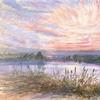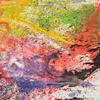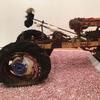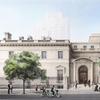Harvard Art Museums Announce Exhibition Examining the Materiality of Recent Sculpture by Doris Salcedo
- CAMBRIDGE, Massachusetts
- /
- September 22, 2016

This fall, the Harvard Art Museums present Doris Salcedo: The Materiality of Mourning, a new special exhibition featuring recent works by Salcedo, an internationally acclaimed artist whose sculpture and installations transform familiar, everyday objects into moving and powerful testimonies of loss and remembrance.
An examination of both mourning and materiality, the exhibition focuses on the last 15 years of Salcedo’s career and the artist’s use of unexpected materials in startling, seemingly impossible ways. Each of Salcedo’s sculptures is a response to political violence and social injustice, and is constructed in such a way that it absorbs the viewer without offering explicit explanation, even for those who have no direct experience of the subject matter. The exhibition was curated by Mary Schneider Enriquez, the Houghton Associate Curator of Modern and Contemporary Art at the Harvard Art Museums, and is on view in the museums’ Special Exhibitions Gallery from November 4, 2016 through April 9, 2017.
A lifelong resident of Bogotá, Colombia, Salcedo began her career producing works that responded to the testimonies of survivors of oppression and political violence in her home country. In recent years, she has broadened her focus to include victims of civil war and oppression worldwide.
“Doris Salcedo’s subject matter is not unique to Colombia or to the impact of civil war; rather, the themes she addresses are current and applicable across the globe. Her work is absolutely timely, and there is no better place than a university museum to focus on the role that art can play in deepening awareness and understanding of such complex issues,” said Martha Tedeschi, the Elizabeth and John Moors Cabot of the Harvard Art Museums. “Through this exhibition we invite all to explore these sociopolitical issues, but also to consider how Salcedo engages with sculpture as a medium, responding to and departing from conventions.”
The Materiality of Mourning focuses on key aspects of the artist’s oeuvre since 2001, examining an important group of Salcedo’s recent works and the decisive challenges they pose to sculpture’s traditions. There are four separate installations, with nine objects in total, including monumental cement-and-wood furniture pieces, ghostly cloaks made of thousands of needles, groupings of contorted stainless steel chairs, and a room-size tapestry composed of rose petals.
“By using materials from one’s private, everyday life in unexpected and unsettling ways, Salcedo transforms the familiar into the strange, producing works that speak vividly and powerfully about the issues she addresses,” said Schneider Enriquez. “Salcedo builds complex layers, centimeter by centimeter, a veritable skin bearing the wounds and history of political violence,” she added.
Accomplishing the “impossible”
Since 2008, Salcedo has incorporated organic materials that challenge temporal limits in her works. She has collaborated with scientists and engineers to find ways for soil, grass, rose petals, and other objects to be suspended in a particular, unlikely state in order to express haunting absence and the silence of remembrance. Testing the properties and parameters of these materials, she deliberately blurs the lines between the permanent and the ephemeral, between sculpture and performance, by creating works that are gestures of mourning. Her most recent sculptures convey a presence just on the verge of disappearing—a parallel to how memories of those lost to violence linger even as they threaten to recede.
“‘Impossible’ is the word that, for me, defines the creative act, an act in which—as Derrida instructs us—one should do only what is impossible,” states Doris Salcedo in her essay in the accompanying catalogue. “The impossible appears in my work when I need to make the ground cry drops of water that will join together to slowly write the names of those victims whose lives this society refuses to grieve. Or when, against all odds, grass grows underneath a wooden table, or when a shroud is made with rose petals that do not wither. Sometimes my task seems impossible, because each time I need to make a radically different piece to honor the singularity of each and every victim’s experience.”
Works on view
The museums’ recent acquisition A Flor de Piel (2013) will be shown publicly for the first time in this exhibition. A room-size tapestry comprised of thousands of carefully preserved red rose petals, hand-stitched together with waxed thread, the work is intended as a shroud for a nurse who was tortured to death in the Colombian war.
Because of its materiality, shape, and size, A Flor de Piel is a complicated piece for the museums to care for and display; it poses unique challenges for conservators. However, the skill and expertise of staff in the Straus Center for Conservation and Technical Studies make the museums the perfect home for such an object. Through intensive discussions with Salcedo’s studio, Narayan Khandekar, senior conservation scientist and director of the Straus Center; Angela Chang, conservator of objects and sculpture and assistant director of the Straus Center; and Schneider Enriquez are exploring how best to protect and care for the work, as they develop plans for its display, storage, and future conservation.
Additional objects in The Materiality of Mourning include a selection of Salcedo’s seminal sculptures, on loan from private and public collections as well as from the artist herself. Several works incorporate domestic furniture in unsettling configurations. Thou-less (2001–02), for instance, is comprised of carved, stainless steel chairs that are at once familiar and strange.
Other works highlight how Salcedo has recently pushed her commitment to materiality and its expressive possibilities to new extremes. These include four works from the Disremembered series (2014–16), individual ephemeral blouse-like sculptures that are constructed of handwoven silk threads filled with tiny needles. Each Disremembered sculpture provides a spectral contrast to Salcedo’s dense, physically imposing works, such as the two Untitled furniture pieces (2008) made of wood, metal, and concrete—with a combined weight of over 1,800 pounds—that will also be shown in the exhibition.
Programming
A lecture and reception on Wednesday, November 2, will mark the opening of Doris Salcedo: The Materiality of Mourning. This free public event includes open hours in the galleries from 5pm to 9pm, and features a discussion at 6pm with artist Doris Salcedo and Harvard College Professor and author Elaine Scarry. Curator Mary Schneider Enriquez will moderate. A celebratory reception in the Calderwood Courtyard follows the discussion.
Narayan Khandekar and Angela Chang, from the museums’ Straus Center for Conservation and Technical Studies, will give a lecture on February 22, 2017, about the challenges of conserving Salcedo’s work. Judith Butler (University of California, Berkeley) will be the keynote speaker for Topography of Loss: A Symposium on Doris Salcedo, to be held March 2–3, 2017, and co-organized by the Harvard Art Museums and the David Rockefeller Center for Latin American Studies (DRCLAS). The Harvard Art Museums will host monthly screenings of Doris Salcedo’s Public Works (2015), a film that documents Salcedo’s site-specific works and ephemeral public projects from the past 15 years, and will partner with DRCLAS and the Harvard Film Archive on an additional four-part film series. Monthly workshops on fabric will be held in the museums’ Materials Lab, and gallery talks will be offered in English and Spanish. Detailed information about programs is forthcoming at harvardartmuseums.org/visit/calendar.
While the exhibition is on view, the museums’ Art Study Center will feature swatches of sculpture made by Salcedo using the same materials and techniques employed in A Flor de Piel; these swatches will be on view during the Art Study Center’s Open Hours on Monday afternoons, from 1 to 4pm, and are also available for viewing by appointment.
Publication
The accompanying catalogue, published by the Harvard Art Museums and distributed by Yale University Press, draws on more than a decade of research by exhibition curator Mary Schneider Enriquez. The book focuses on Salcedo’s works from the 1980s to the present, examining the development and evolution of her approach. The text illuminates the artist’s practice: exhaustive personal interviews and deep research joined with painstaking acts of making that both challenge limits and set new directions in materiality. Schneider Enriquez convincingly argues for viewing Salcedo’s oeuvre not just through a particular theoretical lens, such as violence studies or trauma and memory studies, but for the profound way the artist engages with and expands the traditions of sculpture as a medium.
An essay by conservation scientist Narayan Khandekar explores the artist’s use of organic and nontraditional materials, particularly with regard to the conservation challenges they pose. The catalogue also includes a contribution from Salcedo herself, reflecting on the philosophical underpinnings of her work and on her decision to remain working in her native Colombia.
About the Artist
Doris Salcedo was born in 1958, in Bogotá, Colombia, where she continues to live and work. She holds a B.F.A. from the Universidad de Bogotá Jorge Tadeo Lozano (1980) and an M.A. in sculpture from New York University (1984). She has served as Director of the School of Plastic Arts, Instituto de Bellas Artes, Cali, Colombia (1987–88), and as Professor of Sculpture and Art Theory, Universidad Nacional de Colombia, Bogotá (1989–91). Salcedo has presented solo exhibitions at the Casa de Moneda, Bogotá (1985); White Cube, London (1995, 2004, 2007, and 2012); New Museum of Contemporary Art, New York (1998); Tate Gallery, London (1999); Alexander and Bonin, New York (2000 and 2008); Tate Modern, London (2007); Museo Universitario Arte Contemporáneo, Mexico City (2010); and at the Museum of Contemporary Art, Chicago (2015), among other institutions. She has participated in group exhibitions at the São Paolo Bienal (1998); Liverpool Biennial of Contemporary Art (1999); Documenta, Kassel, Germany (2002); Istanbul Biennial (2003); Turin Triennial of Contemporary Art (2005); Menil Collection, Houston (2008); and Hayward Gallery, London (2010), among many other institutions. Salcedo has received numerous awards and honors, including a grant from the Solomon R. Guggenheim Foundation (1995), the Penny McCall Foundation’s Ordway Prize (2005), the ninth Hiroshima Art Prize (2014), and the inaugural Nasher Prize Laureate by the Nasher Sculpture Center (2016).
Credits
Doris Salcedo: The Materiality of Mourning was organized by the Harvard Art Museums. Curated by Mary Schneider Enriquez, Houghton Associate Curator of Modern and Contemporary Art at the Harvard Art Museums.
The exhibition is made possible by the Nancy A. Nasher and David J. Haemisegger Family, the Charles O. Wood III and Miriam M. Wood Foundation, Marguerite Steed Hoffman and Thomas W. Lentz, Catherine Marcus Rose and William Rose, Bridgitt and Bruce Evans, Mark N. Diker and Deborah A. Colson, and Elaine Levin.
In addition, the following endowed funds have provided crucial support: the Agnes Gund Fund for Modern and Contemporary Art; the Alexander S., Robert L., and Bruce A. Beal Exhibition Fund; and the Harvard Art Museums Mellon Publication Funds, including the Henry P. McIlhenny Fund.
Modern and contemporary art programs at the Harvard Art Museums are made possible in part by generous support from the Emily Rauh Pulitzer and Joseph Pulitzer, Jr., Fund for Modern and Contemporary Art.
Lenders include: Doris Salcedo; Guggenheim Museum, Bilbao; Institute of Contemporary Art, Boston; Neue Galerie, Kassel; Charlotte and Herbert S. Wagner III; and one anonymous lender.
Contact:
Jennifer AubinHarvard Art Museums
jennifer_aubin@harvard.edu
32 Quincy Street
Cambridge, Massachusetts
617-495-9400
http://www.harvardartmuseums.org
About Harvard Art Museums
The Harvard Art Museums, among the world’s leading art institutions, comprise three museums (the Fogg, Busch-Reisinger, and Arthur M. Sackler Museums) and four research centers (the Straus Center for Conservation and Technical Studies, the Center for the Technical Study of Modern Art, the Harvard Art Museums Archives, and the Archaeological Exploration of Sardis). The Fogg Museum includes Western art from the Middle Ages to the present; the Busch-Reisinger Museum, unique among North American museums, is dedicated to the study of all modes and periods of art from central and northern Europe, with an emphasis on German-speaking countries; and the Arthur M. Sackler Museum is focused on Asian, ancient, and Islamic and later Indian art. Together, the collections include approximately 250,000 objects in all media. The Harvard Art Museums are distinguished by the range and depth of their collections, their groundbreaking exhibitions, and the original research of their staff. Integral to Harvard University and the wider community, the museums and research centers serve as resources for students, scholars, and the public. For more than a century they have been the nation’s premier training ground for museum professionals and are renowned for their seminal role in developing the discipline of art history in the United States. The Harvard Art Museums’ recent renovation and expansion builds on the legacies of the three museums and unites their remarkable collections under one roof for the first time. Renzo Piano Building Workshop’s responsive design preserved the Fogg Museum’s landmark 1927 facility, while transforming the space to accommodate 21st-century needs. Following a six-year building project, the museums now feature 40 percent more gallery space, an expanded Art Study Center, conservation labs, and classrooms, and a striking new glass roof that bridges the facility’s historic and contemporary architecture. The new Harvard Art Museums’ building is more functional, accessible, spacious, and above all, more transparent. The three constituent museums retain their distinct identities in this new facility, yet their close proximity provides exciting opportunities to experience works of art in a broader context. harvardartmuseums.org












5100x100_c.jpg)


